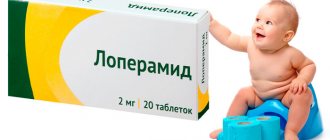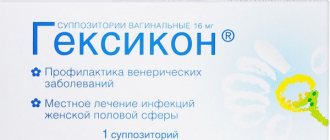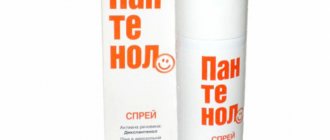Photo: stada.ru
Photo: stada.ru
Photo: gexikon.ru
Photo: karapuz.net.ua
Hexicon D is an antiseptic drug for intravaginal use. Active ingredient: Chlorhexidine.
It is widely prescribed by doctors in pediatric gynecology before the onset of the first menstrual bleeding. It is small in size for more comfortable and painless insertion. Dispensed without a doctor's prescription!
Release form and composition
Dosage form – vaginal suppositories: torpedo-shaped, white or white with a yellowish tint, the surface can be marbled (5 pcs. in blister packs, 1 or 2 packs in a cardboard box and instructions for use of Hexicon D).
Composition of 1 suppository:
- active substance: chlorhexidine bigluconate (in the form of a solution with a concentration of 20%) – 8 mg;
- additional components (suppository base): macrogol 400 (polyethylene oxide 400), macrogol 1500 (polyethylene oxide 1500).
Medicinal properties
When the active ingredient begins to interact with pathogenic microflora, it stops the development and activity of the harmful microbe. Due to its effective effect on bacteria, the drug can not only treat infections, but also prevent their development in the vagina. The medication is active against the causative agents of chlamydia, ureaplasmosis, gardnerellosis, trichomoniasis, treponema pallidum and even against the herpes virus type 2. A significant priority of the product is that the natural microflora in children and women is not disturbed by its use. It is excreted from the body mainly through the intestines.
Pharmacological properties
Pharmacodynamics
The active substance of the drug, chlorhexidine, is an antiseptic that is active against the following microorganisms:
- gram-negative and gram-positive bacteria: Gardnerella vaginalis, Chlamydia spp., Bacteroides fragilis, Ureaplasma spp., Treponema pallidum, Neisseria gonorrhoeae;
- viruses: Herpes simplex types 1 and 2;
- protozoa: Trichomonas vaginalis.
Some strains of Proteus spp. are weakly sensitive to chlorhexidine. and Pseudomonas spp. The drug is not effective against diseases caused by acid-fast bacteria and bacterial spores.
The drug does not interfere with the functional activity of lactobacilli. Remains active (albeit somewhat reduced) in the presence of pus and blood.
Pharmacokinetics
When administered intravaginally, systemic absorption of chlorhexidine is negligible.
Hexicon
Hexicon (INN chlorhexidine bigluconate) is a local antiseptic drug for use in gynecological practice from the Russian pharmaceutical company. Used to prevent genitourinary tract infections in women. Patients of this profile account for about 60% of all visits to the gynecologist. Inflammatory infections can lead to non-hormonal infertility, ectopic pregnancy, miscarriages, and abnormalities in fetal development. Hexicon is an over-the-counter drug that is widely in demand today both as a means of prevention and as a tool for the effective treatment of sexually transmitted infections. The main pathogenic “residents” of the female genitourinary tract are Trichomonas, chlamydia, ureaplasma, mycoplasma, and gonococci. Relief of infectious processes in the genital tract is complicated today by the increased aggressiveness of opportunistic microflora, the widespread phenomenon of drug resistance to antimicrobial drugs, the tendency to reduce the immune status in the general population, and untimely and incorrect diagnosis. The antimicrobial and antiseptic drug Hexicon is distinguished by its speed and breadth of therapeutic action, the scope of which includes bacteria such as Trihomonas vaginalis, Ureaplasma spp., Chlamidia spp., Treponema pallidum, Neisseria gonorrhoeae. Available in dosage forms for local use: vaginal tablets, suppositories, solutions. The advantage of local treatment of sexually transmitted infections is minimizing the risk of developing undesirable side reactions (the vast majority of which are systemic in nature), ease of use, the possibility of use by patients with extragenital (extragenital) pathology, primarily with a localized infectious-inflammatory process (for example, with acute vaginitis, cervicitis, vulvitis or chronic processes in the acute stage).
Hexicon can become a means of emergency prevention of sexually transmitted diseases immediately after unprotected sexual intercourse (but no later than two hours after it). Hexicon has been well studied in several clinical studies conducted in Russia. Thus, in one of them its effectiveness in the treatment of infectious vaginosis was reliably confirmed: 5-7 days of use was enough to normalize the vaginal microflora. The effect of Hexadecone on the microbial biotope of the vagina in women of childbearing age with bacterial vaginosis in the relapse stage was also studied. As a result, the antimicrobial activity of the drug against aerobic and anaerobic microflora and its good therapeutic effect in patients with bacterial vaginosis were established. Chlorhexidine does not affect the functional activity of lactic acid bacteria. The drug retains its antimicrobial activity in the presence of biological fluids (blood, pus). As already noted, Hexicon has only local side effects in the form of rare allergies to chlorhexidine. Pregnancy and breastfeeding are not contraindications to the use of the drug. Hygienic procedures for the external genitalia do not affect the activity and tolerability of Hexicon, since the drug is used intravaginally. No cases of chlorhexidine overdose have been reported to date.
Indications for use
Hexicon D suppositories are used for local treatment of genital infections in pediatric gynecology in girls from 6 months of age until menarche:
- treatment of bacterial vaginosis, vulvovaginitis (including trichomonas, gonorrheal, nonspecific and mixed);
- prevention of infectious and inflammatory complications in pediatric gynecology (before surgical treatment of gynecological diseases);
- prevention of sexually transmitted diseases (including genital herpes, chlamydia, trichomoniasis, gonorrhea, ureaplasmosis, syphilis).
Instructions for use of Hexicon D
| Active substance | Chlorhexidine |
| pharmachologic effect | Antiseptic; Bactericidal; Fungicidal; Virucidal |
| Vacation conditions | Over-the-counter |
| Release form | Vaginal suppositories |
| Pregnancy and breastfeeding | Shown |
| Age group | 6 months + |
| Best before date | 2 years |
| Storage conditions | Not higher than +25 °C |
| Analogs |
|
| Category | Antiseptics and disinfectants |
| Instructions for use (PDF) | Hexicon D vaginal suppositories |
| Manufacturer | STADA (RF) |
| Price | from 269 rub. |
Directions for use and dosage
Hexicon D candles
- If the Hexicon D package is stored in the refrigerator, then it is necessary to remove it and leave it for 15-20 minutes so that the suppository becomes more plastic and softer.
- If the girl is very small, then the candle must be shaped so that it matches the diameter of the hole in the hymen (the doctor should tell you how to do this).
- Having previously freed the suppository from the contour cellular packaging, it is inserted into the vagina in a supine position. It is more convenient to insert the suppository when the child is in the “frog” position (legs brought to the sides and bent at the knees).
- With one hand, spread the labia, with the other, carefully and smoothly insert the suppository completely. Using a cotton swab without a limiter, advance the Hexicon D candle to the size of a cotton head. Next, let the child lie down for a while.
For treatment : 1 Hexicon D suppository for children 2 times a day, for 7-10 days. If necessary, it is possible to extend the course of treatment to 20 days.
For the prevention of sexually transmitted diseases : 1 suppository no later than 2 hours after sexual intercourse.
Compound
- active ingredient: Chlorhexidine bigluconate 8 mg (Chlorhexidine bigluconate is used in the form of a 20% solution);
- excipients: base for suppositories - macrogol-1500 (polyethylene oxide-1500), macrogol-400 (polyethylene oxide-400) - a sufficient amount to obtain a suppository weighing 1.50 g.
The structural formula of Chlorhexidine is C22H30Cl2N10. Photo: Mykhal, ru.wikipedia.org
Indications for use
- The drug Hexicon D, vaginal suppositories, is indicated for the local treatment of genital infections in children, used in pediatric gynecology in girls from 6 months. and before menarche.
- Treatment of vulvovaginitis (including nonspecific, mixed, gonorrheal, trichomonas), bacterial vaginosis.
- Prevention of sexually transmitted diseases (syphilis, gonorrhea, trichomoniasis, chlamydia, ureaplasmosis), infectious and inflammatory complications in pediatric gynecology (for example, before surgical treatment of gynecological diseases).
Contraindications
Hypersensitivity to the components of the drug.
Side effects
The frequency of adverse reactions of Hexicon D according to the WHO classification: very often (≥10%), often (≥1% and <10%), infrequently (≥0.1% and <1%), rarely (≥0.01% and <0.1%), very rare (<0.01%), frequency unknown (cannot be determined based on available data).
Rarely: allergic reactions, itching, which disappear after discontinuation of the drug. Not known: severe allergic reactions, including anaphylaxis.
If any of the side effects indicated in the instructions get worse or you notice other side effects not listed in the instructions, tell your doctor.
pharmachologic effect
Hexicon D is an antiseptic drug for local (intravaginal) use, active against protozoa, gram-positive and gram-negative bacteria, viruses, including Treponema pallidum, Chlamidia spp., Ureaplasma spp., Neisseria gonorrhoeae, Trichomonas vaginalis, Gardnerella vaginalis, Bacteroides fragilis, Herpes simplex type II. Some strains of Pseudomonas spp., Proteus spp. are weakly sensitive to the drug, and acid-resistant forms of bacteria and bacterial spores are also resistant. Hexicon D does not interfere with the functional activity of lactobacilli.
Precautionary measures
Use of Hexicon D during pregnancy and breastfeeding
The drug is not contraindicated for use during pregnancy and lactation (breastfeeding).
special instructions
- Hexicon D retains activity (albeit somewhat reduced) in the presence of blood and pus.
- Suppositories have a reduced size, created specifically for the treatment of girls.
Analogs
Chlorhexidine bigluconate
Pharmacy, Ukraine
The average price in Russia is 20 rubles per bottle.
Chlorhexidine bigluconate is available in the form of a solution for topical use and is a strong antiseptic. They can be used to treat cuts, inflammation, suppuration and places on the skin for injection. It looks like a colorless, transparent, odorless liquid.
Pros:
- It's cheap
- Can be applied to the skin of pregnant and lactating women.
Minuses:
- Hard to find in Russian pharmacies
- It has enough contraindications.
Bepanten Plus
GP Grenzach Produktions, Germany
The average price in Russia is 400 rubles per tube.
The active ingredients are chlorhexidine and dexapanthenol. Available in the form of a white cream for external use. They treat wounds, burns, and inflammation of the skin. Suitable for healing cracked nipples in nursing mothers, and also applied for bedsores or trophic ulcers.
Pros:
- An effective remedy
- Can be used during pregnancy and lactation.
Minuses:
- Expensive analogue
- There are no other forms of release.
Mode of application
The suppository is carefully removed from the contour cell and inserted in a lying position deep into the vagina. The full course of treatment is 7-10 days, 1-2 suppositories should be administered daily, depending on the doctor’s prescription. In more severe cases, treatment can be extended to 20 days.
In the case of using suppositories for adults, in order to prevent the occurrence of sexually transmitted infections, 1 suppository should be administered no later than 2 hours after intercourse.
During pregnancy and breastfeeding
Not assigned.






